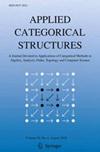一般组合模型范畴中经由同伦末端的同伦极限
IF 0.5
4区 数学
Q3 MATHEMATICS
引用次数: 5
摘要
我们证明并解释了一般(组合)模型范畴中不需要简单充实的同伦极限的几个经典公式。重要的是,我们证明了Bousfield-Kan公式和fat totalization公式的版本。最后,我们证明了同伦终函子保持同伦极限,同样具有完全的普遍性。本文章由计算机程序翻译,如有差异,请以英文原文为准。
Homotopy (Co)limits via Homotopy (Co)ends in General Combinatorial Model Categories
We prove and explain several classical formulae for homotopy (co)limits in general (combinatorial) model categories which are not necessarily simplicially enriched. Importantly, we prove versions of the Bousfield–Kan formula and the fat totalization formula in this complete generality. We finish with a proof that homotopy-final functors preserve homotopy limits, again in complete generality.
求助全文
通过发布文献求助,成功后即可免费获取论文全文。
去求助
来源期刊
CiteScore
1.30
自引率
16.70%
发文量
29
审稿时长
>12 weeks
期刊介绍:
Applied Categorical Structures focuses on applications of results, techniques and ideas from category theory to mathematics, physics and computer science. These include the study of topological and algebraic categories, representation theory, algebraic geometry, homological and homotopical algebra, derived and triangulated categories, categorification of (geometric) invariants, categorical investigations in mathematical physics, higher category theory and applications, categorical investigations in functional analysis, in continuous order theory and in theoretical computer science. In addition, the journal also follows the development of emerging fields in which the application of categorical methods proves to be relevant.
Applied Categorical Structures publishes both carefully refereed research papers and survey papers. It promotes communication and increases the dissemination of new results and ideas among mathematicians and computer scientists who use categorical methods in their research.

 求助内容:
求助内容: 应助结果提醒方式:
应助结果提醒方式:


